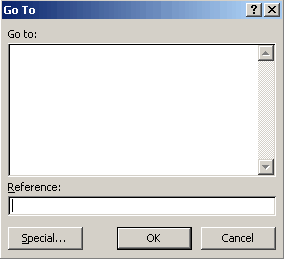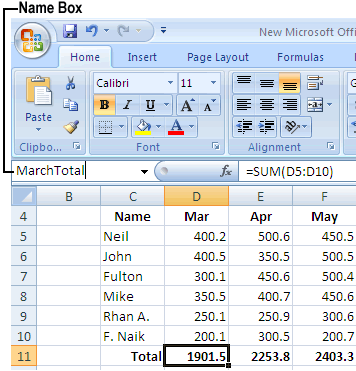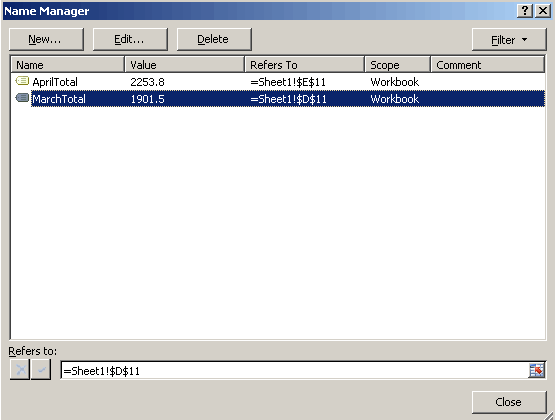Navigating a Spreadsheet
If you have a large spreadsheet, chances are good that information may be hidden by the limitations of your computer screen. To help you view and select cells in different parts of your spreadsheet, Excel offers various ways to navigate a spreadsheet using the mouse and keyboard.
Using the mouse to move around in a spreadsheet
To navigate a spreadsheet with the mouse, you can click the scroll bars or use the scroll wheel on your mouse, if you have one. To use the scroll bars, you have three choices:
- Click the up/down or right/left arrows on the horizontal or vertical scroll bars.
This moves the spreadsheet one row (up or down) or column (right or left) at a time. - Drag the scroll box of a scroll bar.
- Click the scroll area (any area to the left/right or above/below the scroll box on the scroll bar).
This moves the spreadsheet one screen left/right or up/down.
If your mouse has a scroll wheel, you can use this wheel to move through a spreadsheet by two methods:
- Roll the mouse's scroll wheel up or down to scroll your spreadsheet up or down.
- Press the scroll wheel to display a four-way pointing arrow, then move the mouse up, down, right, or left. (When you are done, click the scroll wheel again.)
Using the keyboard to move around a spreadsheet
Using the mouse can be faster to jump from one place in a spreadsheet to another, but sometimes using the mouse can be frustrating, trying to line it up just right. For that reason, you can also use the keyboard to move around a spreadsheet. Some of the common ways to move around a spreadsheet are shown in Table.
Using the Keyboard to Navigate a Spreadsheet
| Pressing This | Does This |
| Up Arrow | Moves up one row |
| Down Arrow | Moves down one row |
| Left Arrow | Moves left one column |
| Right Arrow | Moves right one column |
| Ctrl + Up Arrow | Jumps up to the top of a column that contains data |
| Ctrl + Down Arrow | Jumps down to the bottom of a column that contains data |
| Ctrl + Left Arrow | Jumps to the left of a row that contains data |
| Ctrl + Right Arrow | Jumps to the right of a row that contains data |
| Page Up | Moves up one screen |
| Page Down | Moves down one screen |
| Ctrl + Page Up | Displays the previous worksheet |
| Ctrl + Page Down | Displays the next worksheet |
| Home | Moves to the A column of the current row |
| Ctrl + Home | Moves to the A1 cell |
| Ctrl + End | Moves to the bottom right cell of your spreadsheet |
If you know the specific cell you want to move to, you can jump to that cell by using the Go To command. To use the Go To command, follow these steps:
- Click the Home tab and then click the Find and Select icon in the Editing group. A pull-down menu appears and then click
Go To. The Go To dialog box appears. You can also choose the Go To command by pressing Ctrl+G.

- Click in the Reference text box and type the cell you want to move to, such as C13 or F4.
- Click OK. Excel highlights the cell you typed in Step 2.
Naming Cells
One problem with the Go To command is that most people won't know which cell contains the data they want to find. For example, if you want to view the cell that contains your total amount of money you owe for your income taxes, you probably do not want to memorize that this cell is G68.
To help you identify certain cells, Excel lets you give them descriptive names. To name a cell or range of cells, follow these steps:
- Select the cell or cells that you want to name and then click in the Name box, as shown.

You can type a descriptive name for your cells in the Name box. - Type a descriptive name without any spaces and then press Enter.
After you name a cell, you can jump to it quickly by following this step:
- Click the downward-pointing arrow to the right of the Name box. A list of named cells appears and then click the named cell you want to view. Excel displays your chosen cell.
Eventually, you may want to edit or delete a name for your cells. To delete or edit a name, follow this step:
- Click the Formulas tab and then click the Name Manager icon. The Name Manager dialog box appears.

- Edit or delete the named cell as follows:
To edit the name, click the cell name you want to edit and then click the Edit button. An Edit Name dialog box appears, where you can change the name or the cell reference.
To delete the name, click the cell name you want to delete and then click the Delete button. - Click Close.
